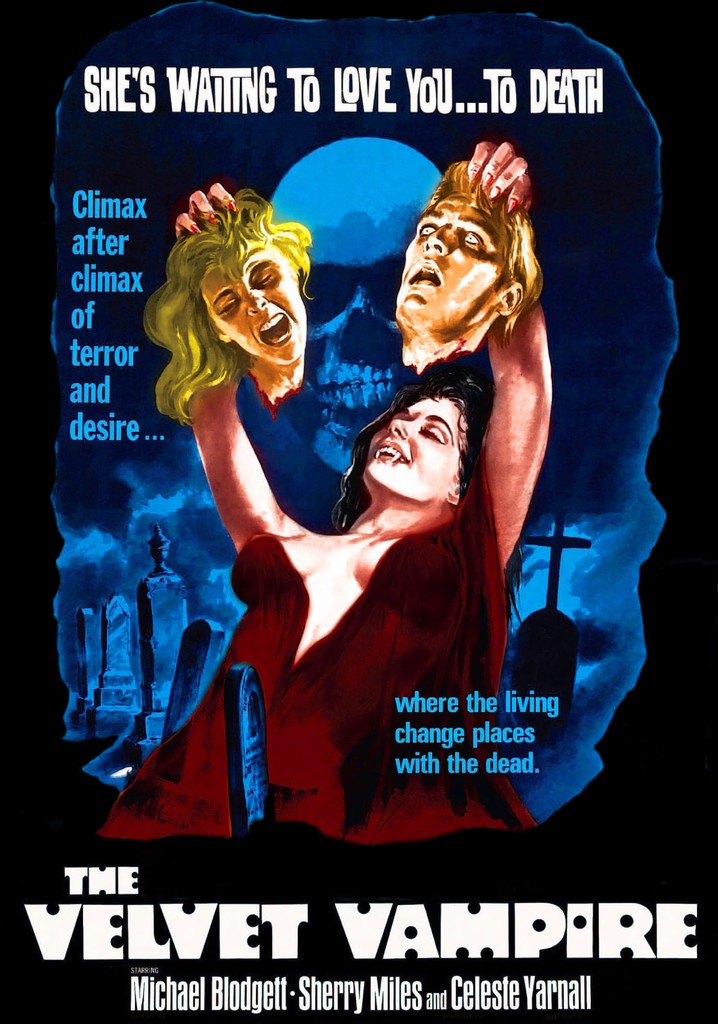|
The Velvet Vampire Film review by Thomas M. Sipos |
|
MENU Books Horror Film Festivals and Awards
Pursuits
Blogs Horror Film Festivals and Awards
Other
|
The Velvet Vampire (1971, dir: Stephanie Rothman, cast: Celeste Yarnall, Michael Blodgett, Sherry Miles, aka Cemetery Girls, The Devil Is a Woman, Through the Looking Glass, The Waking Hour)
See, there's this cat who's hanging out at this art gallery, and he meets this artist chick, who invites him and his old lady to her groovy hideaway in the desert. And this cat, he really digs this chick, so one night they make love, not war. But his old lady catches them, and seems she's got a hangup about free love, so she lays a heavy trip on him. Too bad he doesn't listen, 'cause it turns out this chick is a vampire.... Yes, The Velvet Vampire is a product of its time. A vampire film replete with hippie counterculture icons and attitudes. Lee (Michael Blodgett) feels little compunction about committing adultery with Diane (Celeste Yarnall), and when his wife Susan (Sherry Miles) finds out, he answers: "Okay, so we made love. So what's the big deal?" Director Stephanie Rothman (a Roger Corman protégé) herself seems to share Lee's attitude. Susan is miffed at Lee's infidelity, but quickly shrugs it off. At worst, she threatens to "get back" at him by taking a tumble with Diane herself. Yes, as is common to films featuring young female vampires, Diane swings both ways, although she has no clear preference. In Vampire Movies, Robert Marrero writes that while Diane "has no quarrels about drinking male blood ... it is quite obvious that she prefers women for sex." Well, it's not obvious to me. Diane has a male housemate, and her initial flirtations are directed toward Lee (Michael Blodgett), not Susan (Sherry Miles). Whatever pillow talk she may impart to Susan, Diane's actions speak louder than her words.
The counterculture of the 1960s has not worn well with age. Cinema's 1940s noir anti-heroes remain influential and emulated, whereas onscreen hippies often appear silly, even unintentionally hilarious. Yet The Velvet Vampire overcomes its anachronistic milieu, and remains a beautifully haunting film, this despite a low budget and occasionally rough production values. Its erotic dream desert sequences, underscored with "dreamy" acoustic strings, evoke a psychedelic LSD trip. Possibly, Oliver Stone was influenced by The Velvet Vampire when filming Jim Morrison's desert sojourn in The Doors. The desert dream sequences within the two films share a deep sensibility, although Stone's larger budget naturally allowed him to shoot more than a bed and mirror upon sand. Several critics have praised The Velvet Vampire's desert locale. In Dark Romance: Sexuality In The Horror Film, David J. Hogan regards Rothman's locations to be her "cleverest twists" on the vampire legend, citing both the desert and "clogged streets of Los Angeles." Actually, L.A.'s (ineptly filmed day-for-night) streets are barren at the film's start; and at film's end, the characters never get past the bus station. Still, it's a strikingly memorable scene, intersecting counterculture with vampire mythos. Susan is escaping Diane through the bus terminal, desperate for allies, when she comes upon a gathering of sandal-clad Jesus freaks, looking like extras from Godspell. Eager to help, no questions asked, they descend on Diane with their crosses. The scene is clever, humorous, and strangely poignant. One simultaneously feels sympathy for both Diane and Susan. In The Vampire Film, Silver and Ursini remark on the film's "low-lit interiors full of unnatural colors." I didn't find the colors so unnatural, aside from a blue vs. red-orange lighting contrast, a contrast that appears in many horror films (The Lift, The Last Horror Film, aka The Fanatic). Here, Diane sits in a red room behind a two-way mirror, observing Lee and Susan make love in a bedroom bathe in blue lighting. More than for art decor, I think The Velvet Vampire makes for an interesting study in the cinematic use of costumes. In the film, costumes underscore characters. Morally pure Susan wears bright yellows, whites, and pinks. Only after she puts on a rough earth-toned jacket (lent to her by a gas station owner) is she able to destroy Diane with her cross-wielding hippie cohorts. The vampiric Diane primarily dresses in passionate reds and dark red-oranges when seducing men, but in stiff yellow or white dresses when approaching women. Lee wears "blue-for-boys," but switches to a morally ambiguous striped-shirt after he commits adultery. Juan (Diane's emasculated Indian housemate) wears a pink top along with his blue jeans. A dead mechanic's girlfriend (who is spunkier than Susan) wears a pumpkin-orange top when confronting Diane, but this strong orange color is no match for Diane's red top.
Phil Hardy states in his Overlook Encyclopedia that, despite the film's reputation, he can't see any feminist interpretation to it. I agree there. The Velvet Vampire is essentially about a vampress practicing a parasitic free love, who is finally defeated by an "uptight" woman and her Christian hippie allies. Unfortunately, this inventive and eerily ambivalent penultimate scene is marred by a final scene; a cheap and unnecessary "surprise twist" ending. Another weak point is the film's in-joke homages that are a little ... too too. Diane's last name is La Fanu (her dead hubby, get it?), and she meets Lee and Susan at the. Stoker Gallery (get it?). Even so, The Velvet Vampire is an enjoyable tale, imaginative despite its simple storyline, occasionally tense and brutal, beautifully filmed and scored, and one-of-a-kind. Review copyright by Thomas M. Sipos
|
"Communist Vampires" and "CommunistVampires.com" trademarks are currently unregistered, but pending registration upon need for protection against improper use. The idea of marketing these terms as a commodity is a protected idea under the Lanham Act. 15 U.S.C. s 1114(1) (1994) (defining a trademark infringement claim when the plaintiff has a registered mark); 15 U.S.C. s 1125(a) (1994) (defining an action for unfair competition in the context of trademark infringement when the plaintiff holds an unregistered mark).

 They
don't make 'em like this anymore.
They
don't make 'em like this anymore.